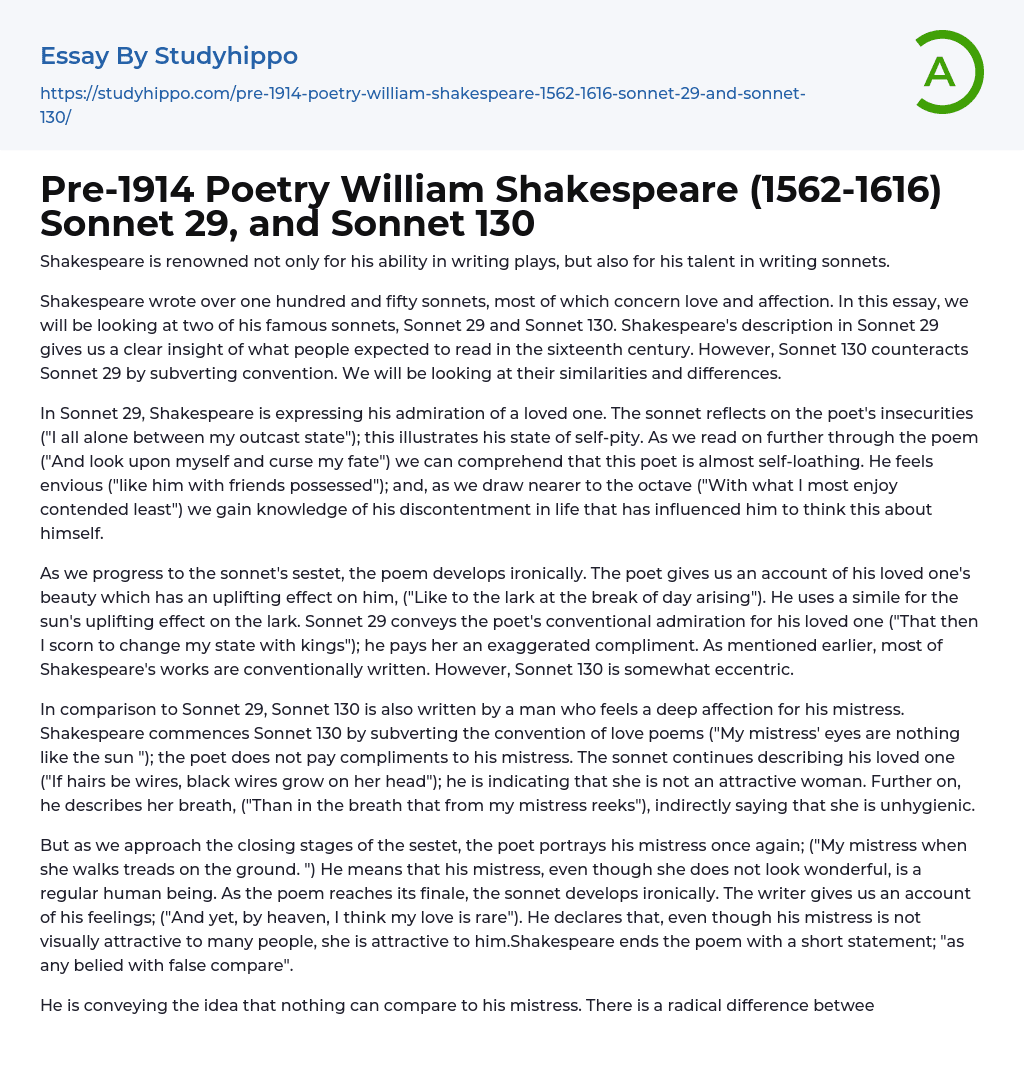

Pre-1914 Poetry William Shakespeare (1562-1616) Sonnet 29, and Sonnet 130 Essay Example
Shakespeare is revered for his mastery in both playwriting and sonnet composition.
Over 150 sonnets were written by Shakespeare, predominantly on love and affection. Two of his renowned sonnets, Sonnet 29 and Sonnet 130, will be analyzed in this essay. While Sonnet 29 provides an understanding of readers' expectations during the sixteenth century, Sonnet 130 challenges these conventions. This essay will explore the similarities and differences between both sonnets.
In Sonnet 29, Shakespeare admires a loved one, while expressing his personal insecurities and self-pity ("I all alone between my outcast state"). The poet's self-loathing is evident throughout the piece ("And look upon myself and curse my fate"), further highlighted by his envy of others' happiness ("like him with friends possessed"). The octave reveals that the poet's discontentment with life ha
...s led him to feel this way about himself ("With what I most enjoy contended least").
As we approach the sestet of the sonnet, an ironic tone emerges in the poem. The poet describes his beloved's beauty in a way that moves him ("Like to the lark at the break of day arising"), using a simile in which the sun lifts the lark. Sonnet 29 expresses the poet's traditional admiration for his loved one ("That then I scorn to change my state with kings"), paying her a hyperbolic compliment. Shakespeare's works are typically conventional, as previously noted, but Sonnet 130 deviates from this norm.
Compared to Sonnet 29, Sonnet 130 is also written by a man expressing his deep affection for his mistress. Shakespeare starts the sonnet by overturning the typical conventions of love poetry ("My mistress' eyes are nothing like the sun"); he does not give compliments to his
mistress. He goes on to describe his beloved ("If hairs be wires, black wires grow on her head"), implying that she is not an attractive woman. Later on, he talks about her breath ("Than in the breath that from my mistress reeks"), indirectly suggesting that she is unclean.
As the sestet nears its end, the poet once again depicts his mistress ("My mistress when she walks treads on the ground.") to emphasize that despite her ordinary appearance, she is a human being. The sonnet concludes with irony as the writer describes his emotions ("And yet, by heaven, I think my love is rare.") asserting that although his mistress may not be visually appealing to others, she is to him. Shakespeare concludes the poem with the statement "as any belied with false compare."
The poet expresses that his mistress is incomparable, highlighting a stark contrast between Sonnet 29 and Sonnet 130. While Sonnet 29 conveys the poet's conventional admiration for his significant other, utilizing exaggerated flattery and depicting the positive impact of her approval on him.
Despite the contrast between Sonnet 29 and Sonnet 130, both aim to celebrate the poets' mistresses. While Sonnet 29 conforms to the societal norms of the 16th century, Sonnet 130 subverts it by rejecting the conventional idea of physical beauty and portraying love through emotions. Thus, Sonnet 130 serves as a rebuttal to Sonnet 29.
Despite the prevalence of love poetry during that era, Sonnet 130 serves to challenge and contradict common preconceptions. The majority of love poems from that time were written with the intention of flattering men's mistresses.
- Allegory essays
- Alliteration essays
- Comedy essays
- Comic book essays
- Drama essays
- Dystopia essays
- Fairy Tale essays
- Fantasy essays
- Fiction essays
- Ghost essays
- Gothic Fiction essays
- Gothic Literature essays
- Irony essays
- Legend essays
- Memoir essays
- Novel essays
- Poetry essays
- Satire essays
- Science Fiction essays
- Short Story essays
- The western essays
- Tragedy essays
- Witchcraft essays
- American Literature essays
- Between The World and Me essays
- Book Report essays
- Book Review essays
- Book Summary essays
- Books essays
- Character essays
- Coming of Age essays
- Dante's Inferno essays
- Everyday Use essays
- Flowers for Algernon essays
- Genre essays
- Greek Mythology essays
- Incidents in The Life of a Slave Girl essays
- Letter essays
- Literary Criticism essays
- Literary devices essays
- Literature Review essays
- Metaphor essays
- Myth essays
- Play essays
- Plot essays
- Poem essays
- Poetry Analysis essays
- Protagonist essays
- Reader essays
- Reason essays



